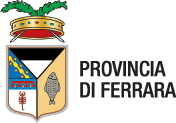Art and culture
National Picture Gallery
Created in 1836, the Picture Gallery was the first public collection of Ferrarese paintings, put together to bring a halt to the dispersion of local artistic patrimony by setting up a modern museum in which to conserve and promote Ferrara's art and culture
Palazzina Marfisa d'Este
TEMPORARILY CLOSED. The Villa is a splendid example of a 16th-century high-class residence and was once surrounded by magnificent gardens that connected it to other buildings known as Casini di San Silvestro.
Palazzo Bonacossi
Palazzo Bonacossi reopens on April 7th, 2022 with a new exhibition
Palazzo Costabili
In 1502 work began on the construction of a large palace on the Via della Ghiara (now Via XX Settembre) for Antonio Costabili, Ferrara’s ambassador at the court of Ludovico il Moro, the Duke of Milan
Palazzo dei Diamanti
The magnificent Palazzo dei Diamanti, at the centre of the Addizione Erculea, on the important crossroads known as the Quadrivio degli Angeli, belonged to the duke’s brother Sigismondo d’Este.
Palazzo Municipale
Begun in 1245, the City Hall was the residence of the Este family until the 16th century. The main entrance is through Volto del Cavallo, opposite the cathedral, and is flanked by two sculptures, copies of the original 15th century ones.
Palazzo Paradiso - Ariostea Library
Temporarily closed until 5 December 2020
Palazzo Paradiso - Ariostea Library
The palace was built in 1391 and decorated with scenes of court life and motifs drawn from the literature of chivalry
Palazzo Renata di Francia
The palazzo was built around 1475, possibly to a design by Pietro Benvenuto degli Ordini.
Palazzo Schifanoia
Extraordinary vestige of the splendour of the Renaissance period, Palazzo Schifanoia is the symbol of Este Ferrara. New itinerary is open to visitors (divided over 1400 square meters, 21 rooms, about 250 works of art), new layout, new lights and new museographic concept, developed with the aim of reconnecting Ferrara with one of the most important testimonies of its history
Palazzo Turchi di Bagno
CLOSED UNTIL FURTHER NOTICE. Designed about 1492 by the architect Biagio Rossetti to create the so-called "Quadrivio degli Angeli" formed by palazzo dei Diamanti and palazzo Prosperi-Sacrati, this building is part of the large-scale urban planning work carried out by Rossetti under the Addizione Erculea plan
Parco Massari
The park takes its name from the adjoining palace, which was built at the end of the XVIth. century, and which has the biggest public gardens within the city walls, covering an area of about 4 hectares.
Parco Pareschi
This was originally the garden of the Estense Palace, said to be of St. Francis, which was built in the second half of the XVth Century by Pietro Benvenuto of the Francescan Order, and then continued by Biagio Rossetti.
Pavilion of Contemporary Art
Open only for temporary exhibitions. CLOSED TO THE PUBLIC BECAUSE OF RESTORATION WORKS.
Piazza Ariostea
This very special oval piazza set below ground level and also famous for the races of the Palio, is the work of the architect Biagio Rossetti.
Piazza Municipale
Piazza Municipale was once the former court of honour of the Ducal Palace that is dominated by the magnificent Scalone d’Onore (stairway of honour) built by Pietro Benvenuto degli Ordini.
Piazza Trento Trieste
The piazza is the beating heart of the city. It dates back to the Middle Ages and the building of the new cathedral dedicated to St. George around which the seats of religious, civil and lordly power, in the shape of the family who in fact ruled Ferrara, were concentrated.
Porta degli Angeli
The Porta degli Angeli was built in 1526, but was already included in the 15th Century design, at the bottom of Via degli Angeli.
Porta Paola
Porta Paola was designed and built in1612 by Giovan Battista Aleotti and dedicated to Pope Paul V who was pontiff at that time.
Quadrivio degli Angeli
The quadrivium was the name given to the crossroads where Corso Ercole d'Este crosses Corso Porta Mare (to the right) and Corso Biagio Rossetti (to the left).
Synagogues
The Jews’ presence in Ferrara dates back at least until the 12th Century and thanks to the religious tolerance of the Este family the community grew, welcoming refugee groups of Ashkenazi from the German Empire territories and later, Sephardic Jews expelled from Spain and Portugal.
Teatro Comunale "Claudio Abbado"
Dedicated to the great conductor, Claudio Abbado, the theatre was built between 1790 and 1797, under the direction of the architects Antonio Foschini and Cosimo Morelli
Temple of San Cristoforo alla Certosa
In 1452, Borso d’Este promoted the construction of a Carthusian monastery away from the core of the city.
The city walls
The ancient Walls of Ferrara encircle the historic centre almost without interruption for nine kilometres, constituting one of the oldest and most impressive...
The Duchesses’ Garden
The Duke’s Garden, also known as “Duchesses’ Garden”, has been organized between 1473 and 1481, after the transformations of Palazzo Ducale, which has been partially rebuilt by the will of Duke Ercole I of Este.
Urban Park G. Bassani
The territory of Barco is located between the city and the river Po. It was one of the Este's game reserves, related to the famous "Delizia di Belfiore", within the walls of the city, and so devoted to the entertainment and amusement of a refined and cultivated court.
Via delle Volte
This charming medieval street marks the axis along which the so-called linear Ferrara developed between the 7th and 9th centuries A.D. and which greatly influenced the further development of the entire city.
Via San Romano
This ancient road was the main link between the market square (currently Piazza Trento e Trieste) and the port, which was situated at the present via Ripagrande.






